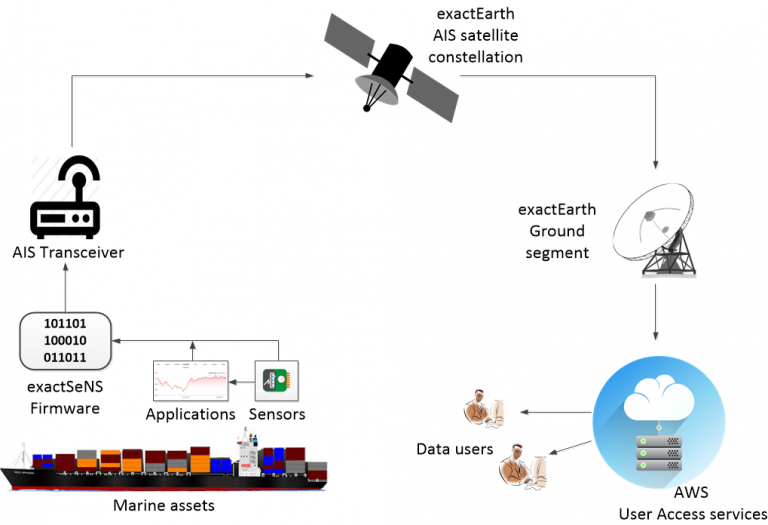IoT applications are appearing everywhere and one of the most challenging environments is that of maritime applications. Not only do solutions need to work in physically harsh surroundings, the majority of operation takes place out of the range of conventional low cost communications. Having to rely on satellite links to transport data can be currently expensive, both for the cost of the terminal equipment and also airtime charges levied by satellite operators.
What can help is a solution that can leverage communication assets that are already available, i.e. existing satellite constellations, which may have a different primary purpose, and existing on-board communications equipment that can be easily upgraded or enhanced with a low-cost replacement.
The European Space Agency (ESA) had previously funded the A-SeNS (‘AIS Sensor Network Service’) project. This completed in July 2017 and demonstrated the viability of using Automatic Identification System (AIS) binary messaging and the Application Specific Message (ASM) maritime VHF frequency to upload sensor data from remote maritime assets. This was a pilot scheme based around a single satellite and showed the viability of the concept through limited trials in the Atlantic and the UK.
Through additional funding from ESA in 2019, exactEarth a world leader in the field of global satellite AIS vessel tracking, has partnered with CML and others to develop a full end-to-end version of the service called ‘exactSeNS’. Using exactEarth’s 58+ satellite AIS constellation to provide real-time coverage, exactSeNS has now been trialled via several real-world scenarios involving commercial end-user partners operating in the maritime marketplace and in varying locations around the world.
The core innovation at the heart of the exactSeNS concept is to use a combination of the existing AIS maritime communications message standard and evolving VDES developments (i.e. the use of ASM frequencies) to offer a new global mobile real-time maritime data retrieval service.
AIS is a collision avoidance / tracking system used by ships and vessel traffic services for identifying and locating vessels by electronically exchanging data with other nearby vessels, shore stations and satellites.
Figure 1 exactSeNS system overview
For its part, CML Microcircuits has incorporated the exactSeNS messaging protocol into its current AIS baseband modem ICs, AIS demonstration platform and VDES module, providing manufacturers with proven off-the-shelf implementations. In all three cases the new functionality has been added as a firmware update, so as well as being available for new designs it also can be made available to AIS equipment already in the field, providing a low cost, low risk upgrade. The upgrade provides a data payload capability within dedicated ASM-based messages transmitted using sophisticated encoding to support reliable reception via satellite. Once received, messages are unencoded and made available in real time to end user applications running on cloud-based servers.
Figure 2 CMX7032 AIS Modem, DE70322T AIS Transceiver and VDES1000 Module
Using exactSeNS a range of data can be collected and made available from a range of sources. Vessel-specific data beyond that usually available via AIS can be made available, e.g. data such as engine parameters, fuel level and economy can be made available to ship operators to drive efficiency and reduce emissions. The system also supports harvesting data from other maritime assets such as buoys, tide gauges, AToNs, etc. which are invaluable for environmental monitoring, all important activates in today’s climate-conscious world.
Whilst new LEO constellations are being launched to target Maritime IoT, building a solution based on an existing operational, extensive and long-life satellite constellation and upgrading existing marine equipment and infrastructure, delivers such solutions today at low cost and low risk. CML Microcircuits provides these solutions as upgrades to existing designs, or a variety of options for new developments ranging from integrated circuits to highly integrated modules.






